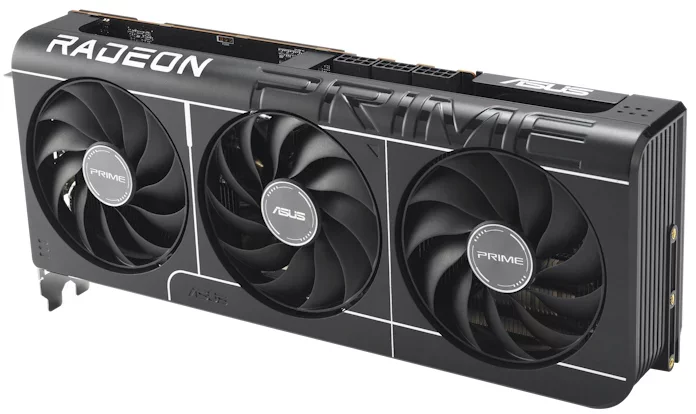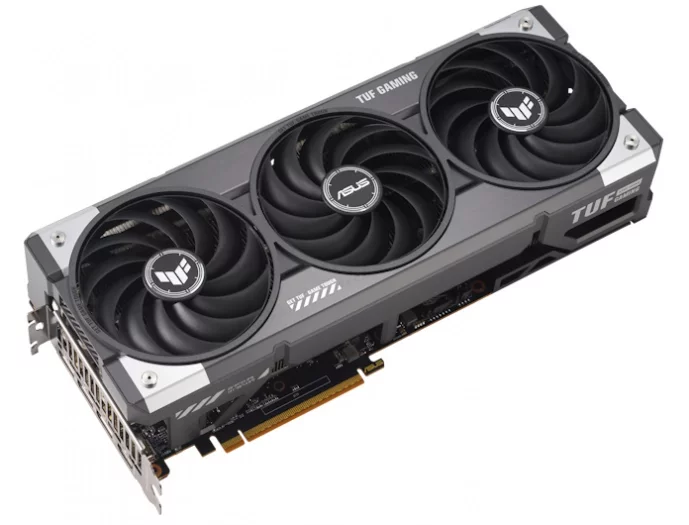When AMD showed next to nothing about new Radeon graphics at its CES 2025 keynote on Monday, there was speculation that it had nothing to offer and/or that the GPUs weren’t ready yet. (But it’s not entirely true that there was no information about the graphics – what the company communicated outside of the “keynote”, we summarized here.) It seems that it was just an appearance, and the new graphics are, on the contrary, closer, they could even come out in January and before the first GeForce RTX 5000.
At the booths of graphics manufacturers at CES 2025, Radeon RX 9070s (apparently mainly XTs) are on display, and AMD also showed the Navi 48 chip itself, which is significantly rectangular and probably larger than expected. It’s a bit tricky to analyze from the photos, but it could be up to around 390 mm², although there have also been more moderate estimates (let’s say 350 mm²). Recall that the GPU is manufactured on a 4nm process, apparently TSMC’s N4.
Could RDNA 4 generation graphics be out as early as January?
At the moment, perhaps the most important piece of information is that fears of a release perhaps sometime at the end of March (since AMD was only talking about Q1 2025) may not come true at all. There have been indications from several quarters that the release will be sooner rather than later. The first was from the company XFX, which said about its graphics (the company exclusively produces Radeon cards, although it started with GeForce 20 years ago) that we should expect more information January 24th.
Respectively, the company even stated on Instagram that the image of the cards “Coming Soon… 24.1.25“, although this may not directly mean the day of availability in stores, it could also be some kind of “event” with a paper reveal (what we expected from CES 2025).
It could be some mistake or noise, but by January other things started to show. In the American store B&H Photo Video, the Radeon RX 9070 and RX 9070 XT (that is, not only the higher model, but also the cheaper one) from Asus appeared in the catalog, with a note that pre-orders will be available from January 23rd (in just two weeks).
Information finally appeared today on the Chinese forum Chiphell, according to which at least part of the reviewers have already started sending card samples (theoretically, it could only be “VIP” media or YouTubers). And the NDA, or information embargo, is reportedly about to expire January 22.
This could either be the day the reviews can come out, or it could be some sort of paper pre-reveal with reviews coming a bit later (and card availability in stores later as well). However, after the release of the reviews, it should be released for sale relatively soon, usually at the same time, or with an interval of only 24 hours. There is a longer time between paper disclosure and reviews/release, but usually only about two weeks, it shouldn’t be more than a month.
Interestingly, if January 22nd, 23rd or 24th marks the release, AMD would finally be able to get the Radeon RX 9070 XT to stores before Nvidia. Its first model, which is to be the GeForce RTX 5080, does not go on the market until January 30. However, these differences are probably more symbolic than practical.
Specifications?
Cards were seen at CES 2025, but no one is yet allowed to reveal anything about the parameters, not even the memory capacity. But Asus revealed this earlier and it should be definitive that both the Radeon RX 9070 XT and the cheaper RX 9070 received 16 GB of GDDR6 memory.
What the photos of the cards showed is that non-reference Radeon RX 9070 XTs will sometimes be powered by three eight-pin connectors, but this is not a necessity – the default configuration has only two connectors, and non-reference graphics with only two eight-pins have already been seen, including relatively higher models (ASRock also has one card with 12+4pin). A trio of connectors might just be a preference (and a reserve for overclocking), as well as thick three-fan coolers. After all, these also appear on significantly more economical graphics for the sake of appearance – small cards don’t look good enough in today’s giant glass cases. In any case, even with two eight-pins, the consumption can go up to the unpleasant range of 300-375 W, so more than two pins outside of OC is probably not necessary.
Today, however, an image from GPU-Z leaked, which could perhaps give a better view of the specifications, again on Chiphell by a leaker with the nickname Apoleon. It is not clear if it is genuine and how reliable the information is, the card is not yet recognized by the software (it turns out to be Radeon RX 7800 XT). But the utility writes that the GPU has 4096 shaders, which should fit, and 256-bit memory, which runs at a clock rate of 20.0 GHz effectively and something (throughput 645 GB/s).
Core clocks should be 2520 MHz base and 3060 MHz boost – if detected correctly. The provisional performance is said to be somewhere around 6345 points in the 3D Mark Speed Way and 14,591 points in the 3D Mark Time Spy Extreme. For now, you should probably put these numbers out of your head, they do not correspond to the final performance, and this card may also be some highly overclocked edition.
Will it be better than people feared?
By the way, this leaker (it should be one of the Chiphell admins and the reviewer) wrote a comment “the situation has changed”, which implies that these graphics could be a positive surprise. If the translation from Chinese is not correct, he recommends not pre-ordering the new GeForce RTX 5000 from Nvidia yet (meaning until their performance can be compared with these Radeons, which may shed a different light on their value) and even “immediately sell” graphics higher than the GeForce RTX 4060 (implied , that their value could suffer significantly) – but the latter may be an exaggeration.
For now, however, take any performance projections with a grain of salt. Various benchmarks appeared on the Internet, but so far there are no official drivers for the cards (those used to test coolers, for example, should be modified so that Furmark can be used on them, but not to measure performance; the previous numbers from 3D Mark could probably already be on drivers that at least support 3D Mark) and therefore no tests are completely reliable.
Those taken with alpha drivers may have lower than real performance, but theoretically also deceptively higher if, for example, the benchmark does not work correctly and does not render all the details or has a lower resolution. As for performance, better wait for the reviews, especially if it’s only the two weeks.
Judging by another comment from leaker Zhangzhogzhao, it seems that perhaps the statement “the situation has changed” is referring to AMD changing the previously intended specs upwards by shifting clocks and needs. Originally, the Radeon RX 9070 XT was supposed to have a TDP of 265W (clarification from the previous information about “26×”), but this is no longer the case, the consumption was apparently increased – even for the reference parameters. The information that the cards could consume 300 W and more is probably confirmed, but apparently this was not the original plan. The graphics, whose image from GPU-Z appeared, seemed to consume 330 W (329 W to be exact) under load according to telemetry. It is unclear whether it was a reference or non-reference model.
Source: www.cnews.cz




